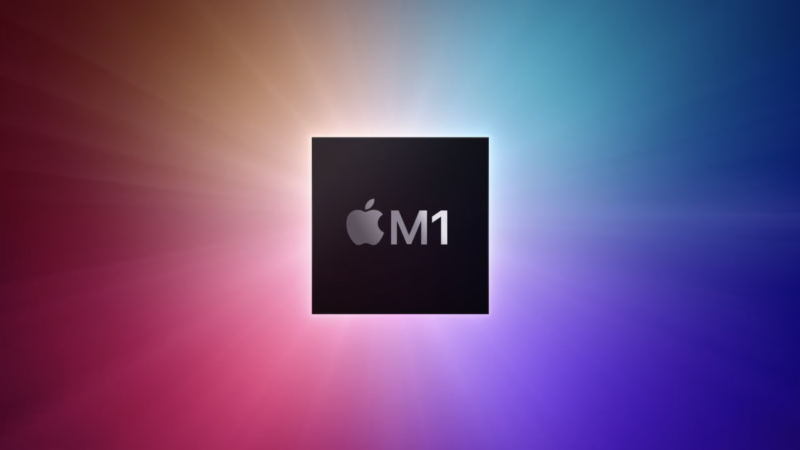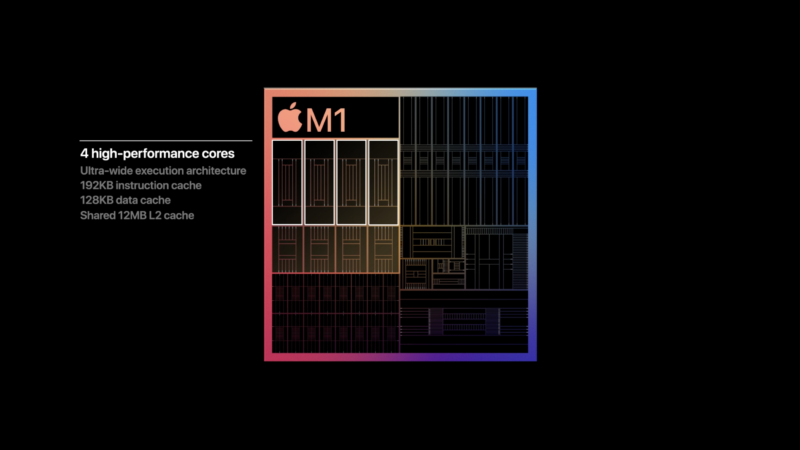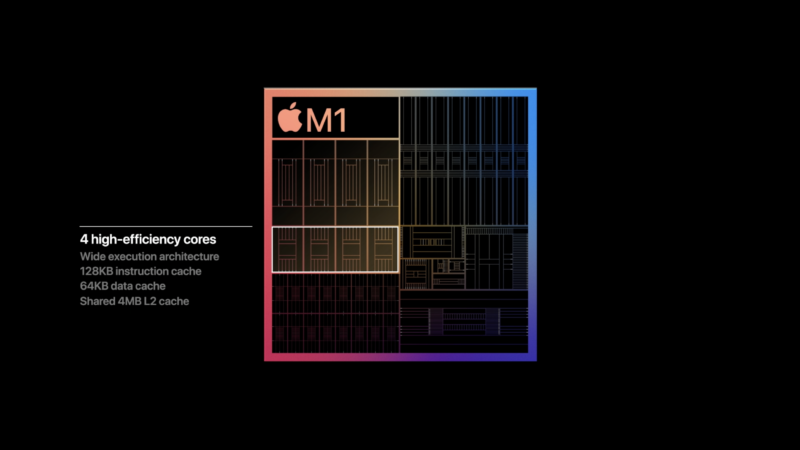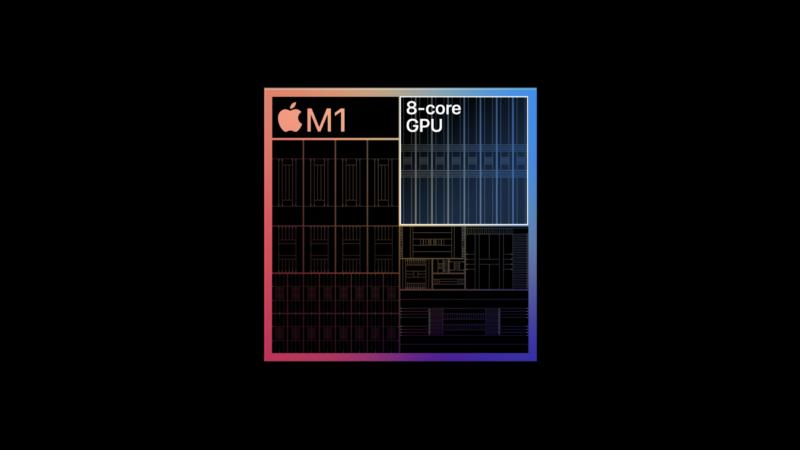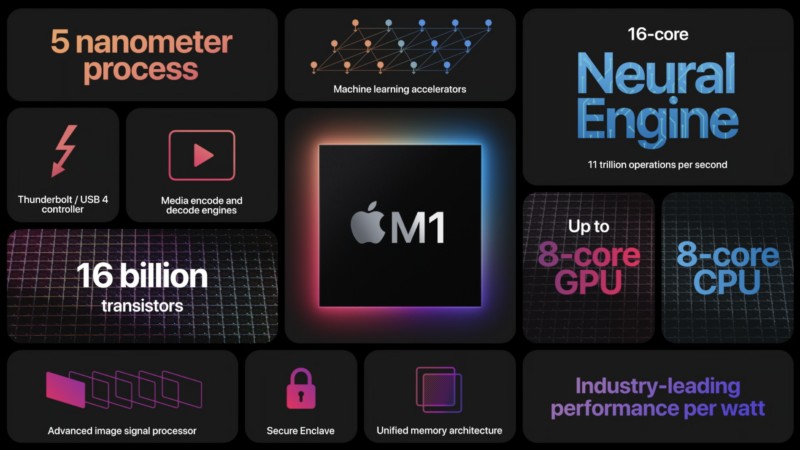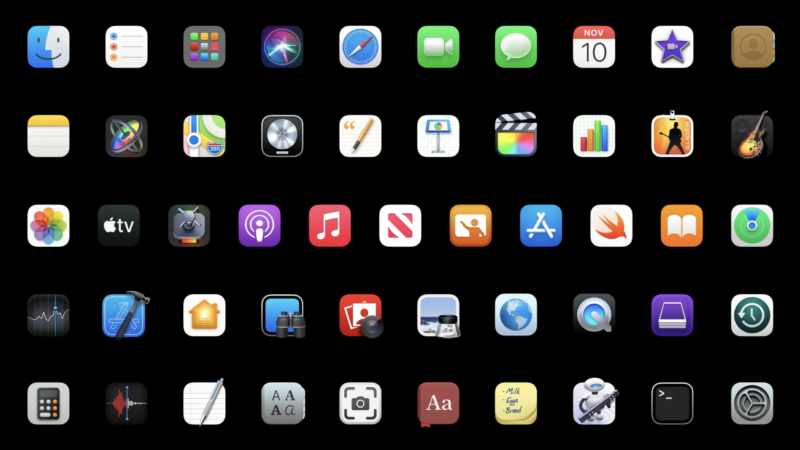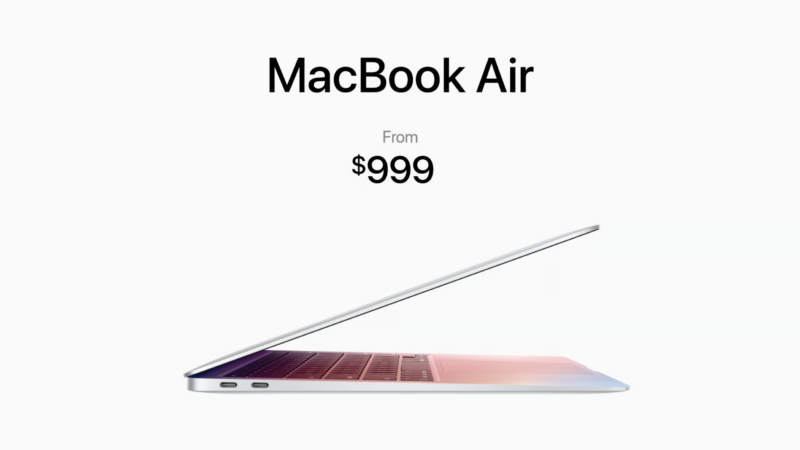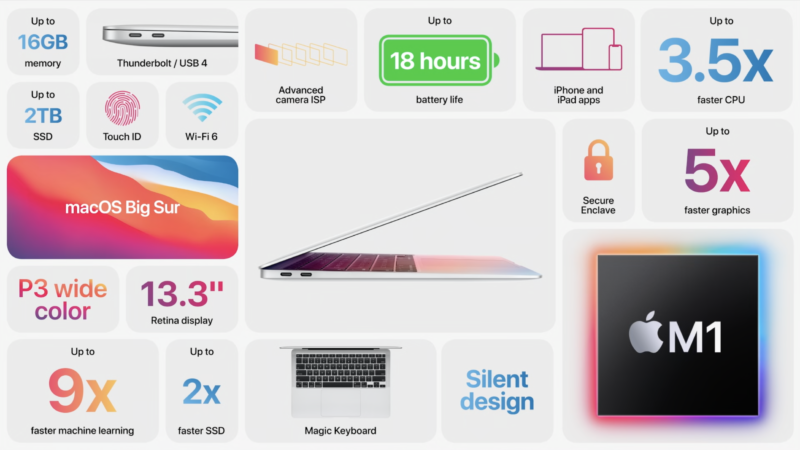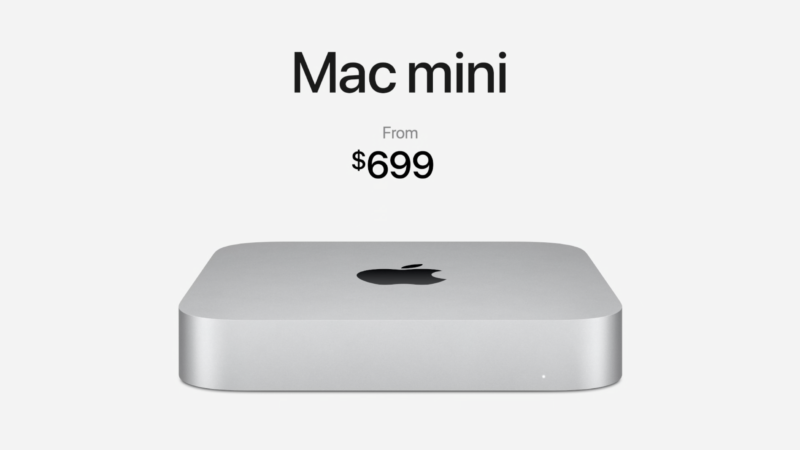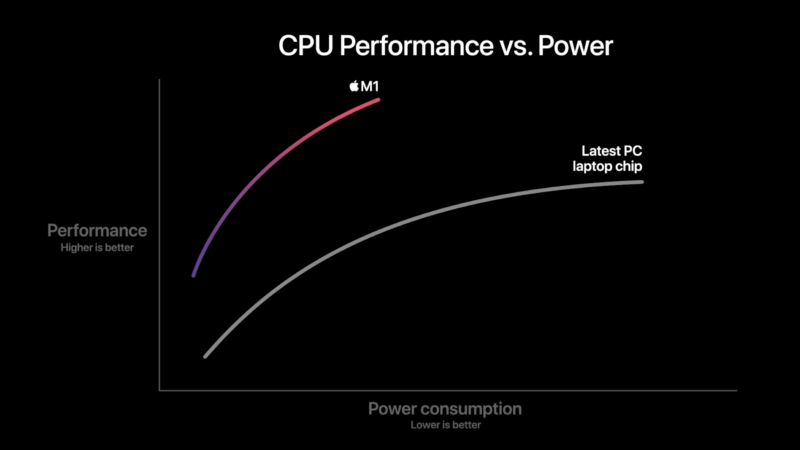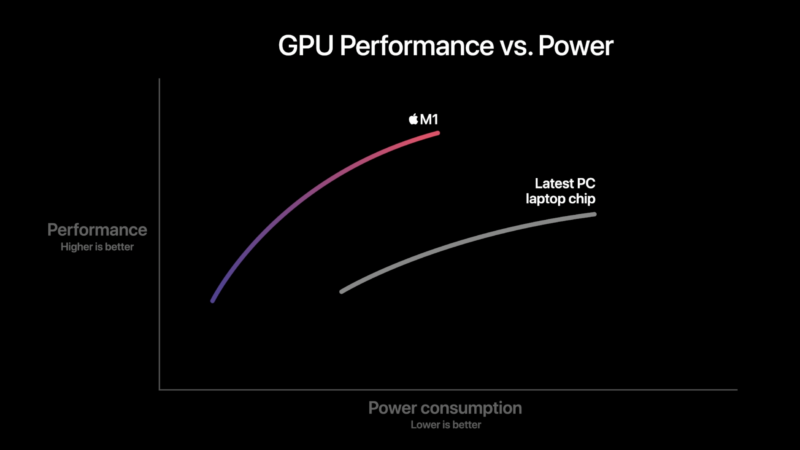In a surprise to no-one, Apple launched its first Apple Silicon Macs today, along with the launch of the M1 processor.
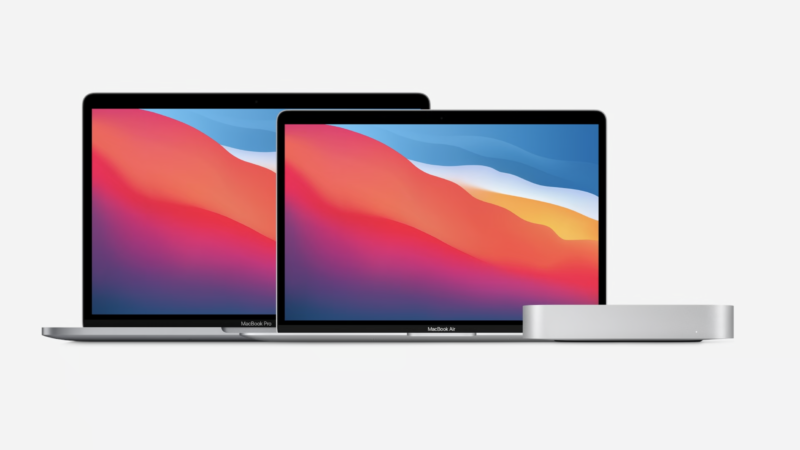
The new Apple Silicon based line up – Screenshotted via the Apple Stream
What’s the M1 processor about?
Current Macs have used Intel-based chips since they transitioned to the platform in 2005, with the first products in 2006. However, Apple has moved a lot faster with the transition to the ARM-based “Apple Silicon” System on a Chip – called M1
The M1 chip follows ARM’s Big.Little design, with 4 performance cores and 4 power-efficient cores, along with up to 8 GPU cores.
The M1 is built on TMSC’s 5-nanometre process, featuring Apple’s Neural Engine, Secure Enclave and a single Unified Memory Architecture. It will also offer Thunderbolt and USB 4 natively.
Unsurprisingly, the M1 has been optimised with MacOS BigSur and Apple’s application suite
In addition, legacy applications should be able to run through the Rosetta2 emulation layer, whilst applications can be deployed as a universal binary – meaning both an Apple Silicon binary and Intel-compatible program can run.
Devices
Three devices were announced today at the event
- MacBook Air with M1 processor – $999 upwards
- MacBook Pro with M1 processor – $1299 upwards
- MacMini with M1 processor – $699 upwards
Performance
This for me a big question. With an Intel Mac, it’s pretty easy to benchmark, and to understand what those scores mean compared to an Intel/AMD based laptop. New benchmarks, of course, means new things to understand.
Apple gives us the following metrics today about the M1 processor.
It’s at this point, I’m stopping drinking the Apple KoolAid and I’m calling dingo here.
These charts tell us approximately nothing. They show a shorter and higher curve, and that’s about it. No comparison of what chip Apple was benchmarking against was disclosed (be it an Intel or AMD CPU). Apple is promising a 2.8x to 3.5x performance increase in CPU performance, whilst GPU performance is set to increase between 5x and 6x.
But again – no comparison of what they’re comparing it against.
Which makes these charts absolutely worthless.
Perhaps our best hope is GeekBench, which can give a reasonable result, a native version of CineBench to give a synthetic CPU performance, or some other independent benchmark, outside the main Apple ecosystem.
Because these numbers as they stand mean nothing.
Software compatibility will be key
As I noted in the announcement post, I’ve got more than a few concerns about binary compatibility. Whilst Apple is promising the world with Rosetta 2 and Universal, Apple Silicon will live or die by developer support. There were a few announcements that companies are getting ready for Apple Silicon-based including:
- Adobe Lightroom (next month) and Photoshop (next year)
- Affinity Publish
- Maxon Cinema 4D
- Davinchi Resolve
Again – the time lag between the Universal/Apple Silicon binaries and the hardware is in the hands of the customers is going to be key.
Should you make the jump?
I’m going to put a big proviso in before I go much further – until independent reviewers get their hands on the new hardware, you should not make any decision to purchase. Unless you love beta testing for Apple free of charge.
I also have concerns about the promised performance and how it translates into real-world tasks.
And a big point to remember: Your current Mac won’t stop working because Apple has released new products.
With that out of the way, I’ll throw a few use-cases out. See which one sticks:
You like paying to beta test the latest technology
Well, off you go then. Pay up and enjoy.
Cloud Worker – You work in the cloud, use Cloud-based applications and maybe use a few of the Apple applications
Go for it. You won’t be impacted too hard by the changes that have been announced and will probably enjoy the new battery life.
You develop in XCode
You should be fine. However, how other libraries will react to BigSur and ARM only, is another question.
You’re a photographer/videographer tied to the Adobe Creative Cloud ecosystem
Wait for a few months until Adobe has their binary-ready versions of Creative Cloud. It took them long enough last time and I can’t see Adobe hurrying to have every application in its Creative Cloud Suite done by the new year.
You rely on Microsoft Office Products
You might be able to get by on running Office via Rosetta, however, you may want to wait until a Universal edition has been released (or published as part of your Office365 account).
You’ve got specific applications that you need to run on a Mac
You’ll need to be talking to your vendor before buying upgrades. And you’ll be working to their timelines when to upgrade your equipment.
You rely on Virtual Machines as part of your work
Forget it for now. For Linux on ARM, there’s a strong chance we’ll see Virtual Machine mangers sooner rather than later. Those who rely on Intel compatibility for virtual machines (eg x86 Linux, Windows, Chromium OS) should consider their options carefully – either stockpiling Intel Macs or be prepared to exit the Mac ecosystem when the time comes.
Major changes – and major questions
We now have some of the big bits of the new Mac architecture coming together, with MacOS BigSur confirmed, the hardware finalised and the first units set to be shipping next week.
But the question of compatibility and performance remain.
These will only be answered once the independent reviewers get them and they can start putting these new devices into real-world use.
…. and will I get one?
Sorry. I don’t pay Apple to be a Beta tester. I’m rather happy with my MacBook Pro 16″ that’s my daily driver (and what I produce my photography and this blog on). And for the work that I do – I need the stability of a fixed platform – which is what MacOS for Intel offers me right now, with the application suite I use (which is Office and Adobe Creative Cloud).
I’ll also add that Apple has not reached out to me over a loan device to review (for that matter, any Apple device I’ve reviewed on this blog has been out of my own pocket and not a press sample or loaner).
And after this post, I doubt they ever will. 😉
Welcome to Economy Class and Beyond – Your no-nonsense guide to network news, honest reviews, with in-depth coverage, unique research as well as the humour and madness as I only know how to deliver.
Follow me on Twitter at @EconomyBeyond for the latest updates! You can follow me on Instagram too!
Also remember that as well as being part of BoardingArea, we’re also part of BoardingArea.eu, delivering frequent flyer news, miles and points to the European reader.
